This blog will focus on a new Windows 11 insider build feature, Administrator Protection, announced in the latest Windows Insider Canary build (27718) and which will be announced at Microsoft Ignite 2024!
This feature is designed to eliminate always-on admin rights. Instead, it uses a hidden elevation mechanism to provide just-in-time privileges when needed, keeping admin rights in the shadows until required. “I am the Shadow Admin, always present but never seen.”
Introduction
Having local admin privileges on a Windows device means having unrestricted control over its configuration, making it a powerful but risky position. Compromised local admin rights are one of the primary entry points for attackers to gain control of a system. For years, User Account Control (UAC) and split tokens have been used to mitigate this risk, ensuring that elevated tasks run under a restricted administrative context. While effective, these mechanisms aren’t foolproof and can be manipulated or bypassed.
Windows 11 introduces Local Administrator Protection to tackle these challenges, a significant enhancement to local admin security. (They even told us how to enable it, that’s nice :))

This feature moves away from traditional split tokens and instead leverages a System Managed Admin Account (internally referenced as ShadowAdmin in the related DLL files). This account is dynamically created and linked to the primary admin account, ensuring that elevated operations run in a separate context. This new model minimizes the exposure of admin rights and offers a robust, isolated environment for privileged operations.
Before diving into the details of this new System Managed admin account, a quick disclaimer: everything shared here is based solely on publicly available information (some funny DLLs) and Open Source Intelligence (OSINT). This is an independent research and is not affiliated with, endorsed, or supported by Microsoft in any way.
Before Administrator Protection
Before Administrator Protection was introduced, things worked quite differently for administrators. When an admin user logged in, Windows created two access tokens: one with full administrative rights and another with standard, limited rights (split token). To reduce risk, your account would only use the powerful admin token when absolutely necessary.

But this approach had a catch. By default, the system uses the limited token for everyday tasks like browsing the web or opening files. However, as soon as you want to install a program or make system changes, you will see the familiar UAC (User Account Control) prompt. This is Windows asking if you really want to use your hidden admin powers, the elevated token. Once you clicked “Yes,” the program you launched would have access to all your admin privileges, exposing that powerful token until the application was closed.

While this protected users from accidentally running malicious software, the admin token was still vulnerable to more sophisticated attacks. Malware could wait until a privileged action was triggered and sneak in to hijack the elevated token while it was active.
How Administrator Protection Will Change the Game
With Administrator Protection enabled Windows completely reworked how these tokens are managed. Instead of keeping the elevated admin token directly linked to your account, it moves it into a hidden, system-managed admin profile. Think of it as locking away your admin key in a secure vault that only Windows itself can access.
Now, when you attempt an elevated action, Windows doesn’t just flip a switch to activate your admin token. Instead, it switches to an isolated managed system admin account that holds the token safely. Your original account remains in its standard user state and is isolated from any admin rights. The elevated admin token is only temporarily “borrowed” for that specific task, and as soon as it’s done, it’s locked back up and the shadow account vanishes.
This new method means that even if malware lurks in your system, it can’t capture or misuse the elevated admin token. Unlike before, where the token could be hijacked mid-task, the hidden nature of the system-managed profile prevents direct access. The admin token only exists temporarily, eliminating the opportunity for malicious code to grab it.
So, while the old method used two tokens directly tied to the user account, one for normal tasks and one for admin rights. Administrator Protection separates them completely. This keeps the powerful elevated token out of sight and out of reach, making it much harder for attacks to exploit admin privileges.
Understanding the Administrator Protection Mechanism
As mentioned in the previous paragraph, Administrator Protection aims to reduce the attack surface by dynamically creating and linking a System Managed Admin Account to the local admin whenever an elevation is required. This method effectively eliminates the need for split tokens and ensures that elevated tasks are handled securely in an isolated environment. Unlike Endpoint Privilege Management (EPM), which uses a virtual account for elevation, the System Managed Admin Account is a persistent, real user account stored in the SAM database.
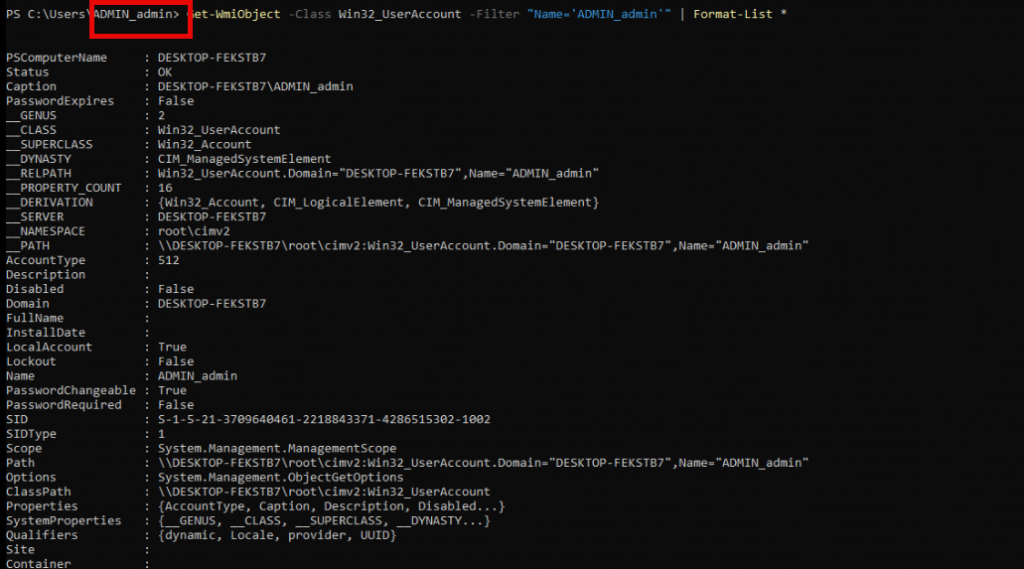
How to Enable Administrator Protection
You can enable Administrator Protection using either Group Policy or Intune:
- Enabling Administrator Protection with Group Policy:
- Open Group Policy Editor (
gpedit.msc). - Navigate to:
Computer Configuration -> Windows Settings -> Security Settings -> Local Policies -> Security Options. - Configure User Account Control: Configure type of Admin Approval Mode to “Admin approval mode with Administrator protection”.
- Restart the device.
- Open Group Policy Editor (

- Enabling Administrator Protection with Intune:
- Log into the Intune Portal.
- Create a Settings Catalog Policy and set:
- User Account Control Type of Admin Approval Mode: “Admin Approval Mode with enhanced privilege Protection”.
- User Account Control Behavior Of The Elevation Prompt: “Prompt for consent on the secure desktop”.
- Assign the policy and restart the device.

Please Note: After changing the User Account Control behavior of the elevation prompt for administrator protection, you will need to reboot your device.
What Happens in the Background?
Once Administrator Protection is enabled, the system dynamically creates the System Managed Admin Account for each existing local admin account (Except the account managed by Windows LAPS. This account is protected and can’t be tampered with) on the device using the ShadowAdminAccount::CreateShadowAdminAccount function (samsrv.dll).
Please note: Samsrv.dll is a very important DLL file. Check out my Windows LAPS blog for more information


After enabling the Administrator protection feature, the system creates a new account named ADMIN_<randomized>. (your local admin account name) for each local admin account.
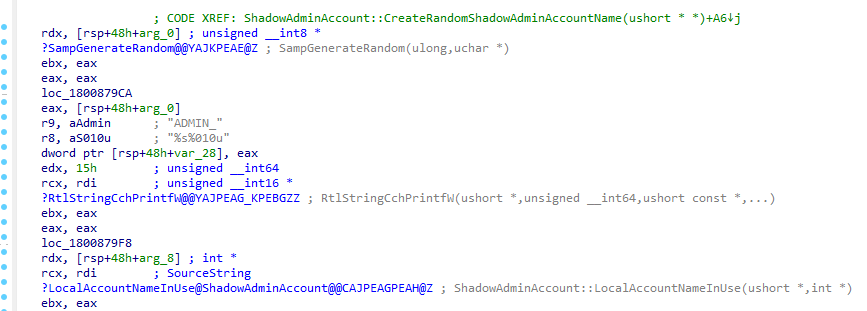
So, for example, as shown below, I had three local admins on the device: admin, admin, and test admin. An additional “shadow account,” aka System Managed Admin Account, was created for each of them.

With the account name being randomized, two specific attributes are configured in the SAM database:
- ShadowAccountForwardLinkSid: Created under the main admin account’s registry path, linking it to the new System Managed Admin Account

- ShadowAccountBackLinkSid: Created in the System Managed Admin Account registry path, linking it back to the main admin account.

Once created and “linked”, the ShadowAdminAccount::AddAccountToLocalAdministratorsGroup function adds the the additional System Managed Admin Account to the Local Administrators group.


This integration ensures that the System Managed Admin Account account has the necessary permissions to perform privileged operations, bypassing the need for UAC split tokens.
Summary of the System Managed Admin Account Creation Flow:
- Randomized Naming:
- The function
ShadowAdminAccount::CreateRandomShadowAdminAccountNamegenerates a random name corresponding to the primary admin account (e.g.,ADMIN_testadminfortestadmin). - This ensures that each System Managed Admin Account is unique and linked to its parent admin.
- The function
- Linking Accounts in the SAM Database:
- During creation, a Forward Link SID is stored in the primary admin’s SAM entry, mapping it to the System Managed Admin Account.
- Simultaneously, a Back Link SID is created in the System Managed Admin Account’s SAM entry to bind it back to the primary admin.
- Adding to the Local Administrators Group:
- After creation,
ShadowAdminAccount::AddAccountToLocalAdministratorsGroupis called, adding the System Managed Admin Account to the Local Administrators group. - This ensures that the System Managed Admin Account has full administrative privileges, allowing it to execute elevated tasks without relying on split tokens.
- After creation,
With the System Managed Account created, can we start using it?
Elevating a Process with Administrator Protection Enabled
After enabling the administrator protection and rebooting the device, let me show you what happens when I am logged in with a local administrator account and try to run the command prompt as administrator.

You will be asked for your credentials or consent depending on the setting you configured in the user account control behavior.
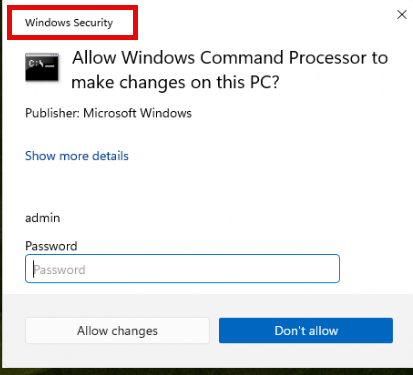
Did you spot the Windows Security at the top? After entering the password and clicking on allow changes, the cmd will be opened within the System Managed Admin Account context. Shall we take a small peak at that one? But before we do, I need to explain how Appinfo.dll is involved.
Appinfo Background Information
Before diving in even deeper, let’s start with some information about Appinfo and why this file/service is pretty important in the whole elevation process

Primary Role: UAC and Elevation Requests
appinfo.dll is integral to the Windows Application Information Service (also called the “AppInfo” service), which is directly involved in UAC handling.
It governs the interaction between the User Interface Privilege Isolation (UIPI) system, token manipulation, and whether an application is run as a standard user or with elevated rights. Whenever a user or application initiates an action that requires administrative privileges, appinfo.dll evaluates the request and determines the next steps.
Launch of Consent.exe
One of its most visible roles is launching the consent.exe process, which displays the familiar UAC dialog box asking for user approval to elevate an application. I

t also decides whether to prompt for user consent, or bypass the prompt based on group policies and local settings. Shall we take a look at the elevation process now?
The Elevation Process
Initiating Elevation & Registry Check:
- When a local administrator initiates an action needing elevated permissions, Appinfo.dll checks the registry for the
TypeOfAdminApprovalModekey (HKLM\Software\Microsoft\Windows\CurrentVersion\Policies\System).
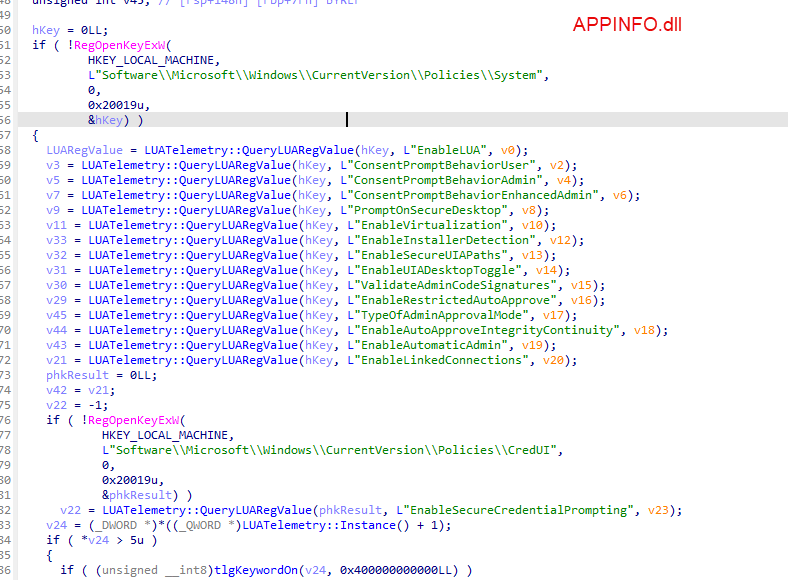
- If Admin Approval Mode with Administrator Protection is enabled, Appinfo.dll knows that the elevation request should be handled by a System Managed Admin Account account, not the legacy admin approval mode.

Launching Consent.exe:
- Once the registry validation is complete, Consent.exe is launched by Appinfo.dll to handle the elevation prompt.
- The role of Consent.exe is pivotal here. It reads the linked Forward Link SID from the SAM database in the primary admin’s account path and verifies it against the Back Link SID in the System Managed Admin Account’s path

Checking the System Managed Admin Account Link:
- Consent.exe calls the function
CreateShadowAdminLinkto map the main admin’s token to the System Managed Admin Account’s SID.

- This establishes a secure link between the main admin and the System Managed Admin Account, ensuring that elevation operations are handled under the isolated System Managed Admin Account profile.
Switching to the System Managed Admin Account Context:
- Appinfo.dll dynamically switches the current session to the System Managed Admin Account context.
- The UAC prompt uses Admin Approval Mode with specific visual indicators like the Windows Security title and a distinct color scheme, signaling that the process runs in an isolated context.
Launching the Task Securely:
- The process is then launched under the System Managed Admin Account, ensuring no interaction with the primary admin’s context.

Security Validation via SAM Database:
- Throughout the elevation process, the system references the Forward Link SID and Back Link SID entries to ensure the request’s legitimacy.
- This validation prevents rogue processes from impersonating the System Managed Admin Account,, providing additional security by strictly isolating privileges.
The Difference between Administrator Protection and EPM
If you’re curious about how Administrator Protection compares to Endpoint Privilege Management (EPM), check out my latest blog, where I dive into the key differences between the two. Both features manage admin privileges but in distinct ways. Administrator Protection focuses on securing admin tokens, while EPM allows standard users to elevate privileges for specific tasks. I also discuss a common issue they both share—how elevated tasks can sometimes break file ownership or user context. You can read the full comparison here.
https://call4cloud.nl/windows-11-administrator-protection-vs-epm
Administrator Protection and the Entra Accounts
While Administrator Protection helps secure local admin accounts by restricting token exposure, adding Entra ID accounts to the local Administrators group makes things interesting.
This is where ShadowAdminPairs comes into play. It is a hidden registry key that Windows relies on to map Entra identities to local admin privileges. But what happens if that key disappears? Well, let’s just say things start breaking in unexpected ways.
To find out what would happen, I deleted the ShadowAdminPair SID and the outcome was pretty funny. If you’re curious about what happens when ShadowAdminPairs is removed and how it impacts Entra local admin mappings, check out this additional deep dive.
Conclusion
The introduction of Administrator Protection and the System Managed Admin Account concept marks a fundamental shift in managing local admin rights. Microsoft mitigates many traditional UAC vulnerabilities by decoupling elevated tasks from the main user context, making the local admin a safer role. Administrator Protection sets a new standard as the security landscape evolves, transforming local admin privileges from a constant risk into a well-guarded asset.

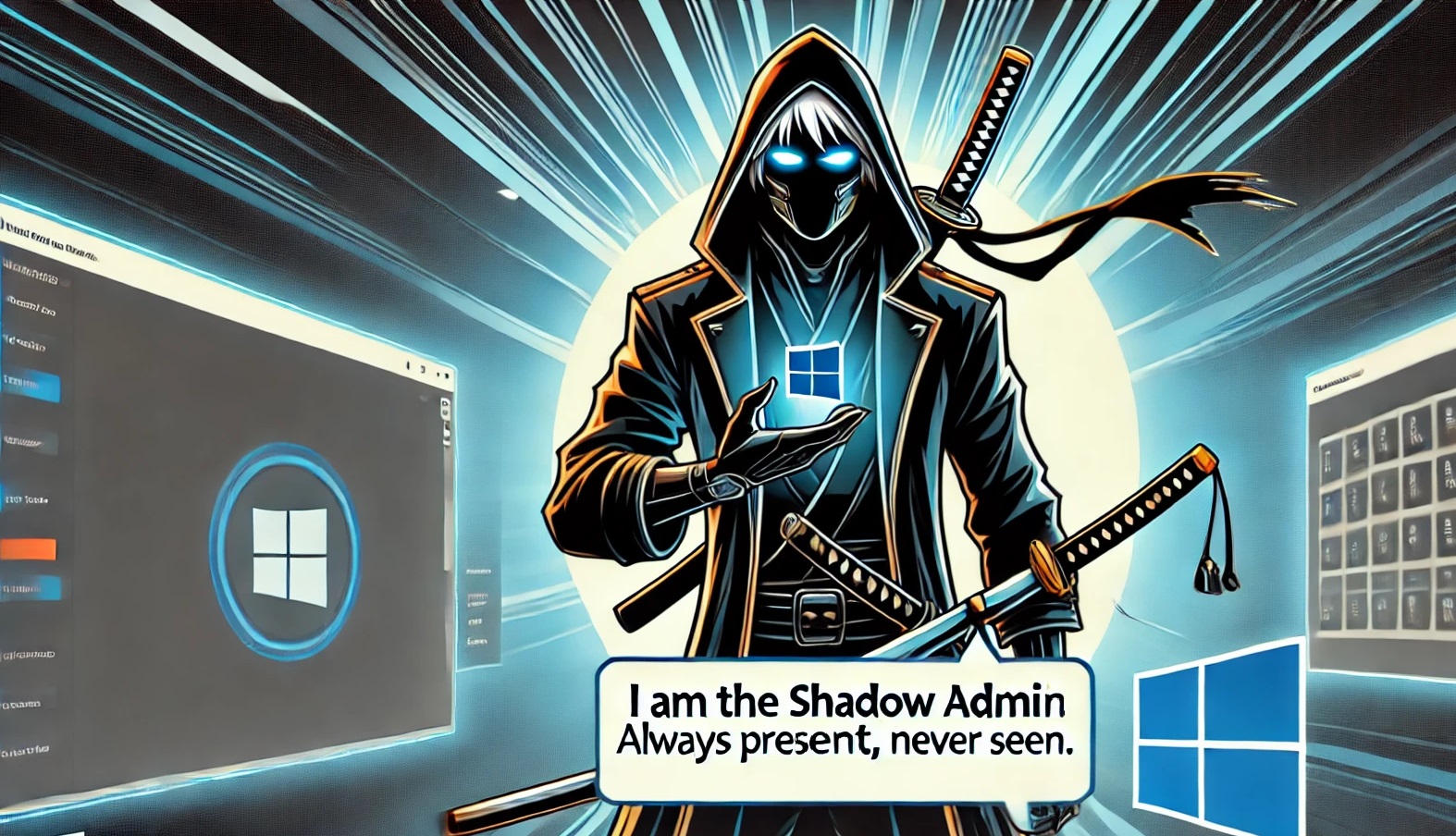

Hi, what is the foreseen synergy between W11 Administrator Protection and Microsoft Intune (or any other vendor) Endpoint Privileged Management? Or will this make EPM software and tools unnecessary? Thanks!
Running Windows Canary.. as soon as i active it via gpedit.msc and reboot i get an Windows Logon error (The resource loader cache doesn’t have loaded MUI entry) and can’t sign in to the device anymore.
Did you had activated it before? as i stumbled upon that same error. but that was more because the vm was a little bit abused 🙂
Will this also work with the “Microsoft Entra Joined Device Local Administrator” role that is added to the local administrator group, or do the entra accounts need to be added to the local administartor group?
I tried to deploy this via intune. The report shows that the policy is set and I rebooted my pc, but when i try to run cmd as administrator I get the UAC prompt and not the Windows Security prompt.